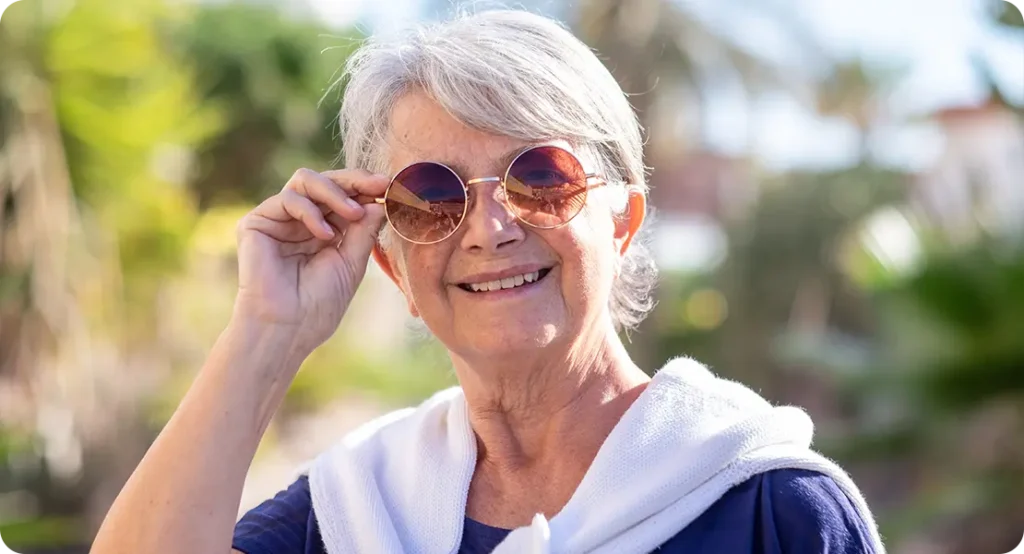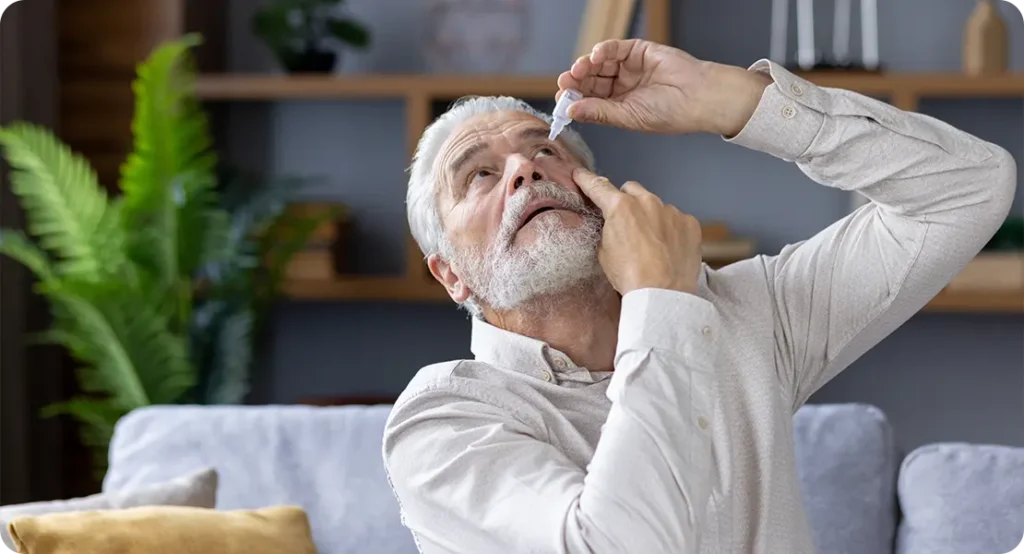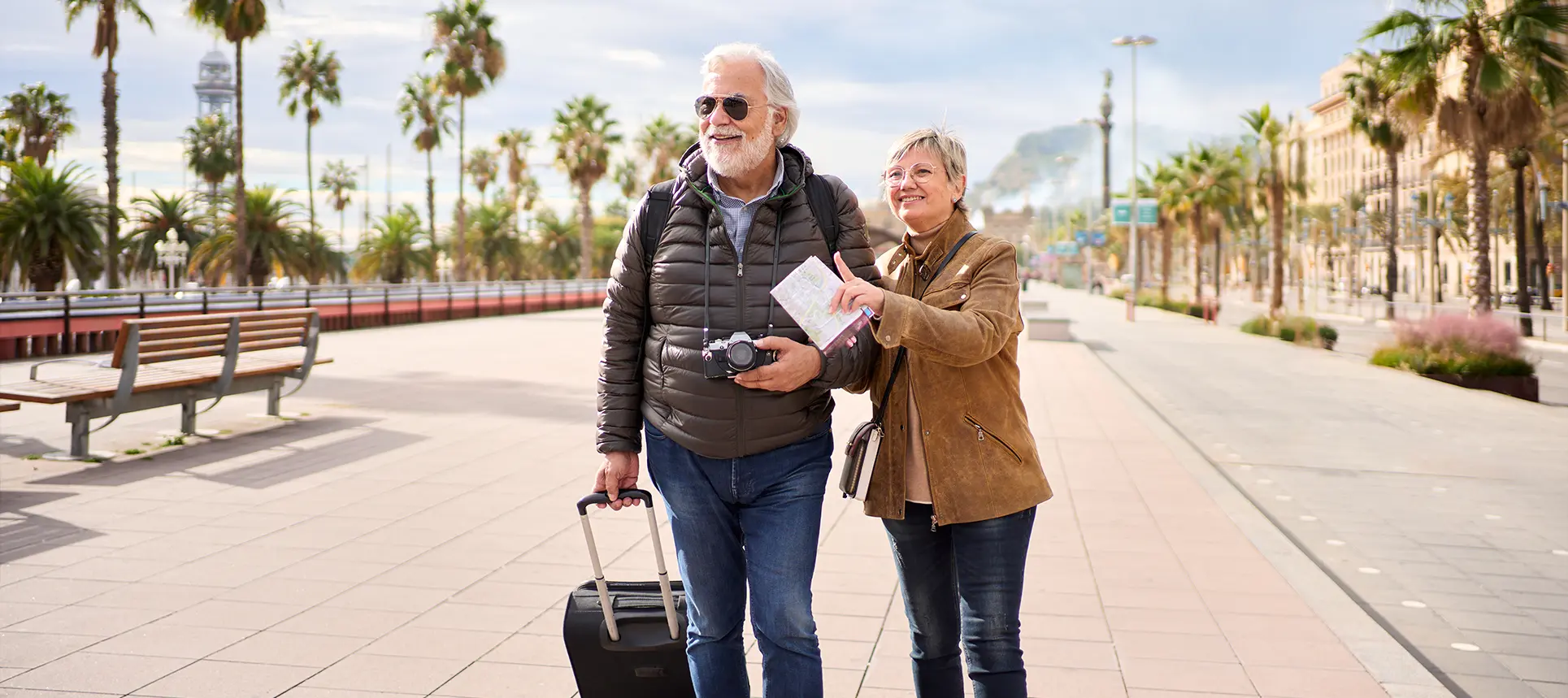So, you’ve had your cataract surgery – vision clearer, world brighter, and life looking a little more in focus. Now, you’re probably itching to plan that long-awaited holiday or visit family abroad. But before you start packing your suitcase and hunting for your passport, it’s worth pausing for a moment to make sure you’re fully prepared for travel after your eye operation.
This guide will walk you through everything you need to think about – from when it’s safe to fly to how to protect your eyes in sunnier climates and manage your medication abroad. Let’s make sure your next trip is stress-free and your recovery stays on track.
How Soon Can You Travel After Cataract Surgery?
The First Few Days Matter Most
Cataract surgery might be quick, but your eyes still need time to heal properly. Most surgeons recommend avoiding any kind of strenuous activity for at least a week after surgery – and that includes travel. Even if you’re feeling fine, the first few days post-op are crucial for healing. The incision made in your eye needs time to seal properly, and flying too soon could introduce unnecessary risks, especially due to cabin pressure changes and potential exposure to germs.
Short Trips vs Long Journeys
A short train ride to the countryside? Probably fine after a few days. A long-haul flight to Australia? That’s another story. As a general rule of thumb, many eye specialists advise waiting at least a week before flying, and potentially longer for long-haul flights – often around two weeks or more, depending on how your recovery is going. If you’re unsure, your surgeon is your best point of contact. Everyone’s healing time is slightly different, and your doctor will know if your eyes are up to the task.
The Risk of Infection While Travelling
One of the biggest concerns when travelling shortly after surgery is exposure to infection. Airports and aeroplanes are packed with germs – it’s just the nature of those spaces. After cataract surgery, your eye is more vulnerable to bacteria, so the last thing you want is an eye infection on holiday. If your journey can wait a little longer, that extra bit of recovery time could really help reduce your risk.
Can You Fly After Cataract Surgery?
Travelling by air after cataract surgery is usually safe, but timing is everything. While many people can resume light activity within a day or two, flying introduces some unique factors that make it wise to wait a little longer. The most important thing is that your eye has had a chance to begin healing properly before being exposed to the dry, pressured environment of an aircraft. Typically, patients are advised to hold off on flying for at least one week after the operation, although individual circumstances—like having stitches or other complications—might require a longer delay.

It’s also worth considering how taxing travel itself can be. Airports, security queues, lifting luggage, and being in close contact with crowds can put strain on your body and increase the chance of infection. If your flight is particularly long or you’re travelling to a destination without easy access to medical care, these risks need to be weighed carefully. Speak to your consultant before making any travel bookings—they’ll base their advice on how your eye is responding post-surgery and whether the journey could potentially interfere with healing.
Cabin Pressure and Your Eye
One of the main concerns people have about flying post-surgery is the effect of cabin pressure on the eye. Thankfully, cataract surgery doesn’t involve any gas inside the eye, so the risk from pressure changes during a flight is very low. That said, the eye is still healing, and the tissue is delicate, especially around the incision site. If your procedure included additional treatments or there were any complications, your surgeon might recommend waiting longer or avoiding flights altogether for a period of time.
There’s also the matter of inflammation or internal swelling, which can be affected by flying too soon. While it’s rare, even mild swelling could be aggravated by pressure changes, so it’s crucial to make sure your follow-up checks confirm everything is settling as expected. Most importantly, always get personalised advice from your ophthalmologist before deciding to fly—they can give you a clear go-ahead based on how well your eye is recovering.
Dealing with Dry Cabin Air
Airplane cabins are notorious for their low humidity, often dipping below 20%, which is significantly drier than normal environments. For someone who has just had eye surgery, this can be quite uncomfortable. Healing eyes can become more sensitive to dry conditions, leading to irritation, itching, or a gritty sensation. This is why lubricating eye drops become a travel essential for post-op patients, especially for longer journeys where the dryness can intensify over time.
It’s a good idea to apply eye drops before boarding and periodically during the flight, depending on how your eyes feel. Look for preservative-free options as they tend to be gentler, especially on sensitive or healing eyes. Wearing an eye mask can also help reduce exposure to cabin air while resting, and it may also help prevent you from touching or rubbing your eyes inadvertently. Staying hydrated by drinking water also supports general eye comfort, as internal hydration helps the eyes stay moist.
Eye Shields and Safety Glasses in Transit
Your surgeon may have advised you to wear a protective eye shield during sleep for the first week or so, and it can be a smart move to bring it with you on flights too. Turbulence, accidental nudges from other passengers, or even a sudden shift in your seat could lead to a knock to the eye. Having the shield handy gives you the option to protect your eye during naps or moments when you feel at risk of bumping it inadvertently.
In addition to the shield, some people opt for safety glasses or wraparound sunglasses while travelling. These not only offer physical protection from accidental knocks but also shield the eye from dust, debris, and airborne particles that are common in airports and on planes. If you’re heading to a sunnier location, a good pair of sunglasses will serve both purposes—protection from UV rays and a barrier against environmental irritants. Whichever option you choose, comfort and safety should be your priority while your eye is healing.
Why UV Protection Is Extra Important
After cataract surgery, your eyes may feel more sensitive to light, particularly sunlight and glare. This happens because the natural lens, which might have had some filtering capacity, has been replaced, and in some cases, the new artificial lens may not provide the same level of UV protection. Even when the replacement lens has a UV filter built in, it’s still a good idea to wear sunglasses, especially in bright environments, to reduce eye strain and prevent long-term damage to the retina.
Excessive exposure to UV rays can increase the risk of developing further eye issues down the line, such as macular degeneration. That’s why it’s not enough to simply grab any pair of sunglasses—look for ones that specify 100% UVA and UVB protection. Larger frames or wraparound styles are ideal as they provide more complete coverage. This extra care will not only protect your healing eye but also maintain your overall eye health for the future.
Sunglasses and Sun Hats: Your Best Friends
When you’re newly post-op and heading outdoors, the right accessories can make a big difference. A wide-brimmed sun hat offers a simple but effective way to reduce the amount of direct sunlight reaching your face and eyes. Combined with sunglasses, you create a shaded environment that helps reduce glare, making it more comfortable to be outside, particularly in sunny destinations or reflective environments like beaches.

This extra protection becomes especially useful if you’re spending extended time outdoors, whether you’re sightseeing or just relaxing. In the days and weeks following surgery, even diffused sunlight can feel intense, so it’s worth being cautious. A lightweight, breathable hat and high-quality sunglasses should be packed as essentials—think of them not just as comfort items, but as protective gear during your healing journey.
Be Careful with Swimming and Adventure Activities
Water might look inviting on a warm day, but post-cataract surgery, it’s not worth the risk. Swimming pools, lakes, and the sea all carry bacteria that can easily enter your healing eye and lead to infections. Even chlorinated water in pools doesn’t eliminate all risks, especially when it comes into contact with an open or vulnerable eye surface. Most doctors recommend avoiding swimming entirely for at least two to four weeks to allow your eye to heal properly.
Beyond swimming, it’s wise to avoid any activities that involve dust, wind, or rapid motion. These can all irritate the eye and may even lead to injury. Activities like motorbiking, dune buggy rides, or hiking in dry, windy conditions might need to wait a bit longer than you’d hoped. While it’s tempting to jump back into an active lifestyle, it’s smarter to ease back in gradually, ensuring your eye is fully healed and protected throughout.
Keeping Your Eye Drops Cool and Safe
Most cataract patients will be given a combination of antibiotic and anti-inflammatory drops to use for several weeks following surgery. These drops are crucial in preventing infection and reducing inflammation, and they must be stored properly to remain effective. Exposure to excessive heat, which is common during holidays, can degrade the quality of these medications. So, if you’re travelling somewhere warm, it’s worth investing in a small insulated pouch or travel cooler to keep them at the right temperature.

When storing drops while in transit, keep them in your hand luggage rather than checked baggage. This gives you quick access during the journey and protects the drops from temperature extremes in the aircraft hold. If your hotel room doesn’t have air conditioning, look for a cool spot in your room or even ask reception if they can store your drops in a fridge if needed. It may sound like a hassle, but taking this step ensures you don’t compromise the effectiveness of your post-op care.
Don’t Skip Doses – Even in Different Time Zones
Staying on schedule with your eye drops is vital, even when you’re on holiday. It’s easy to get distracted when you’re sightseeing or adjusting to a new time zone, but skipping doses can increase your risk of infection or delay healing. Set reminders on your phone or watch to help you stay on track, and keep a small travel-sized chart if you’re the type who prefers pen and paper.
If your travel plans take you across time zones, it can be confusing to figure out when to take your next dose. A good rule of thumb is to keep the interval between doses consistent, even if it means adjusting the timing gradually over a day or two. If you’re unsure, ask your surgeon or pharmacist for a personalised dosing schedule that fits your travel itinerary. With a bit of planning, you can stay consistent without too much disruption.
Take More Than You Need
When it comes to medication, it’s always safer to over-prepare. Flights get delayed, plans change, and sometimes we extend our holidays without thinking through the practicalities. Running out of post-op eye drops in a foreign country can become a real hassle, especially if replacements are hard to find or require a local prescription. Bring extra with you—at least a week’s worth beyond what you expect to need.
It’s also wise to carry a printed copy of your prescription and a short letter from your ophthalmologist explaining your condition and treatment. This becomes especially important in countries where English isn’t widely spoken, as it can help local pharmacists or doctors assist you more effectively if needed. Some people even carry a translated version of their prescription, just in case. That way, you’re covered no matter where your travels take you.
Bring a Medical Letter for Airport Security
Navigating airport security with prescription drops and eye care supplies is easier if you’ve got the right paperwork. Since many eye drops exceed the standard 100ml liquid limit, having a letter from your ophthalmologist explaining your recent surgery and the necessity of the medication can save you a lot of hassle at the checkpoint. It can also be useful if you’re carrying additional items like a gel eye mask or sterile wipes.
This letter doesn’t need to be long—just a clear, signed statement on clinic letterhead will usually do the trick. Be sure to keep it in an easily accessible part of your hand luggage so that if you’re questioned, you can quickly present it without fuss. Having this sorted in advance not only keeps things smooth but also gives you one less thing to worry about as you focus on your recovery and enjoy your trip.
Think About Travel Insurance with Medical Cover
After a surgical procedure like cataract removal, it’s vital to check whether your travel insurance policy covers you adequately. Many standard policies exclude cover for recent operations unless you’ve disclosed them in advance. If you end up needing treatment abroad due to an eye complication, you could be stuck with a hefty bill if your insurer refuses to pay out. It’s better to be safe than sorry, even if it means paying a slightly higher premium.

Look for a policy that specifically includes recent medical procedures and ask for confirmation in writing. Some insurers may require a letter from your ophthalmologist stating that you’re fit to travel—this can be organised at your post-op follow-up. While it might seem like extra admin before your holiday, proper medical cover can give you peace of mind and ensure you’re protected in case anything goes wrong while you’re away.
Pack a Travel-Ready Eye Kit
Having a well-prepared travel kit can make a huge difference in your comfort and safety while away. At the very least, pack your prescribed drops, a spare bottle of lubricating eye drops, and your protective eye shield if you’re still in the early healing phase. Add in your sunglasses and sun hat for daytime outings, and consider including a small mirror to help with drop application if you’re travelling solo.
It’s also handy to carry a few extras like sterile wipes for cleaning around the eye, a soft cloth for your glasses, and a mini cooler bag if you’re heading somewhere hot. Put everything in a small pouch so it’s easy to grab from your bag when you need it. Having all your essentials in one place not only helps with organisation but also gives you that reassuring sense that you’re prepared for anything your trip might throw at you.
When to Delay Travel: Red Flags Not to Ignore
Ongoing Blurriness or Visual Disturbances
If your vision still seems blurry, you’re seeing flashes of light, or you notice new floaters in your vision – it’s better to hold off on your trip. These can be signs of complications, like retinal detachment or infection, and need to be checked out immediately. Even if you’ve booked everything, your eyesight should always take priority.
Redness, Pain, or Discharge
A little mild redness or irritation is normal after surgery – but if your eye becomes very red, starts hurting, or you notice any sort of discharge, don’t ignore it. These symptoms can point to an infection or inflammation that needs treatment straight away. The last thing you want is to be dealing with a serious eye issue in a foreign country.
Not Cleared by Your Surgeon Yet
This one’s simple – if your surgeon hasn’t cleared you for travel, then don’t go. They’ll likely want to see you for a follow-up appointment a week or so after surgery to check that your eye is healing well. After that, if you’re given the green light, then you can start thinking about packing your bags.
Final Thoughts: Travel Smart, See the World Clearly
Getting cataract surgery can feel like lifting a veil – colours are sharper, details clearer, and your confidence behind the wheel or reading a book shoots up. So it’s no surprise you might want to celebrate with a getaway. But even a simple trip requires a bit more planning when your eyes are still healing.
Take it slow, listen to your doctor, protect your eyes from sun and germs, and stay on top of your medication. With just a few smart precautions, you’ll be able to enjoy your travels without risking your results. After all, what’s the point of better vision if you can’t use it to see the world?
Safe travels – and enjoy the view.

